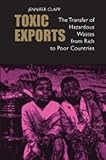Toxic Exports : The Transfer of Hazardous Wastes from Rich to Poor Countries / Jennifer Clapp.
Material type: TextPublisher: Ithaca, NY : Cornell University Press, [2018]Copyright date: ©2010Description: 1 online resource (192 p.) : 5 tablesContent type:
TextPublisher: Ithaca, NY : Cornell University Press, [2018]Copyright date: ©2010Description: 1 online resource (192 p.) : 5 tablesContent type: - 9781501735936
- 363.72/87/091724 23
- online - DeGruyter
| Item type | Current library | Call number | URL | Status | Notes | Barcode | |
|---|---|---|---|---|---|---|---|
 eBook
eBook
|
Biblioteca "Angelicum" Pont. Univ. S.Tommaso d'Aquino Nuvola online | online - DeGruyter (Browse shelf(Opens below)) | Online access | Not for loan (Accesso limitato) | Accesso per gli utenti autorizzati / Access for authorized users | (dgr)9781501735936 |
Frontmatter -- Contents -- Preface -- Acronyms -- 1. Hazard Transfer from Rich to Poor Countries -- 2. The Hazardous Waste Trade and International Regulatory Measures -- 3. The Role of Environmental NGOs in the Evolution of the Basel Ban -- 4. Industry Players and Post-Basel Ban Amendment Politics -- 5. Foreign Direct Investment in Hazardous Industries -- 6. Market-Based and Voluntary Initiatives: Promoting Clean Productiont -- 7. Conclusion: Prospects for Clean Production on a Global Scale -- Index
restricted access online access with authorization star
http://purl.org/coar/access_right/c_16ec
In recent years, international trade in toxic waste and hazardous technologies by firms in rich industrialized countries has emerged as a routine practice. Many poor countries have accepted these deadly imports but are ill equipped to manage the materials safely. For more than a decade, environmentalists and the governments of developing countries have lobbied intensively and generated public outcry in an attempt to halt hazardous transfers from Northern industrialized nations to the Third World, but the practice continues. In her insightful and important book, Jennifer Clapp addresses this alarming problem.Clapp describes the responses of those engaged in hazard transfer to international regulations, and in particular to the 1989 adoption of the Basel Convention. She pinpoints a key weakness of the regulations—because hazard transfer is dynamic, efforts to stop one form of toxic export prompt new forms to emerge. For instance, laws intended to ban the disposal of toxic wastes in the Third World led corporations to ship these byproducts to poor countries for "recycling." And, Clapp warns, current efforts to prohibit this "recycling movement" may accelerate a new business endeavor: the relocation to poor countries of entire industries that generate toxic wastes. Clapp concludes that the dynamic nature of hazard transfer results from increasingly fluid global trade and investment relations in the context of a highly unequal world, and from the leading role played by multinational corporations and environmental NGOs. Governments, she maintains, have for too long failed to capture the initiative and have instead only reacted to these opposing forces.
Mode of access: Internet via World Wide Web.
In English.
Description based on online resource; title from PDF title page (publisher's Web site, viewed 26. Apr 2024)


